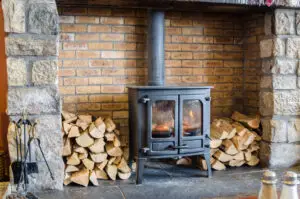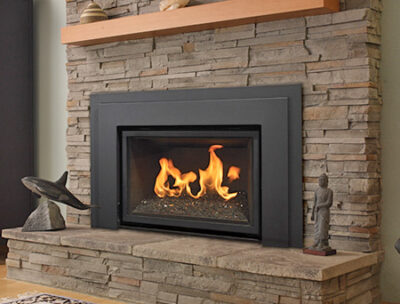Are you thinking of adding a gas fireplace to your home but wondering how much gas does a gas fireplace use and how much it might cost to run? In this article, we’ll delve into the question of how much gas a gas fireplace uses and how that usage translates into cost.
The amount of gas that a gas fireplace uses can vary depending on several factors, including the size of the fireplace, the efficiency of the unit, and the length of time that it is used. On average, a gas fireplace can use between 40,000 and 50,000 BTUs per hour.
However, this can range from as low as 20,000 BTUs per hour for a small, efficient unit to as high as 100,000 BTUs per hour for a larger, less efficient unit. It’s important to consult the manufacturer’s specifications or consult with a professional to determine the exact gas usage of your gas fireplace.
How much gas does a gas fireplace use?

The amount of gas that a gas fireplace uses will depend on a number of factors, including the size of the fireplace, the efficiency of the unit, and how frequently it is used. In general, gas fireplaces tend to use less gas than traditional wood-burning fireplaces, but the amount can still vary significantly.
Here are a few things that can affect how much gas a gas fireplace uses:
1. Size of the fireplace: Larger gas fireplaces will typically use more gas than smaller ones simply because they have a larger surface area that needs to be heated.
2. Efficient design: Some gas fireplaces are designed to be more efficient than others, which means they use less gas to produce the same amount of heat. Look for a fireplace with a high AFUE (Annual Fuel Utilization Efficiency) rating, which measures the percentage of fuel that is converted into useful heat.
3. Frequency of use: The more often you use your gas fireplace, the more gas it will consume. If you only use it occasionally, it will use less gas than if you use it every day.
It’s difficult to provide a specific estimate of how much gas a gas fireplace will use, as it will depend on the factors listed above and other variables. However, you can consult the manufacturer’s documentation or speak to a professional to get a better idea of how much gas your particular fireplace is likely to consume.
How to calculate the gas usage of a gas fireplace
There are a few steps you can take to calculate the gas usage of your gas fireplace:
1. Determine the size of the fireplace: The size of the fireplace will affect how much gas it uses, as larger fireplaces will require more gas to heat the same area. Look for the manufacturer’s documentation or measure the dimensions of the fireplace yourself to determine its size.
2. Find the AFUE rating: The AFUE rating measures the efficiency of the fireplace, with higher ratings indicating more efficient models. This rating can be found in the manufacturer’s documentation or on the Energy Star website.
3. Determine the cost of gas: Find out the current cost of natural gas in your area by checking with your gas company or by looking up prices online.
4. Estimate the usage: To calculate the gas usage of your fireplace, you can use the following formula:
(Size of the fireplace in square feet) x (AFUE rating) x (Hours of use per year) x (Price of natural gas)
For example, if you have a fireplace that is 500 square feet in size, has an AFUE rating of 80%, and you use it for 2 hours per day, 365 days per year, the calculation would be:
(500 square feet) x (0.8) x (2 hours/day) x (365 days/year) x (Price of natural gas)
This will give you an estimate of the annual cost of using your gas fireplace. Keep in mind that this is just an estimate, and actual gas usage may vary based on other factors, such as the efficiency of the fireplace and the ambient temperature.
Factors that affect the gas consumption of a gas fireplace
There are several factors that can affect the gas consumption of a gas fireplace:
1. Size of the fireplace: The larger the fireplace, the more gas it will consume.
2. Type of gas being used: Different types of gas have different energy densities, which can affect the amount of gas consumed. For example, natural gas has a higher energy density than propane, so a fireplace using natural gas will consume less gas than one using propane.
3. Burn rate: The burn rate, or the rate at which the gas is burned, can also affect gas consumption. A fireplace with a high burn rate will consume more gas than one with a low burn rate.
4. Heat output: The heat output of the fireplace, or the amount of heat it produces, can also affect gas consumption. A fireplace with a high heat output will consume more gas than one with a low heat output.
5. Usage: The frequency and duration of use can also affect gas consumption. A fireplace that is used frequently and for long periods of time will consume more gas than one that is used infrequently and for short periods of time.
6. Ventilation: Proper ventilation is important for the safe and efficient operation of a gas fireplace. If the fireplace is not properly ventilated, it can consume more gas than it should.
7. Maintenance: Regular maintenance, such as cleaning and adjusting the gas controls, can help ensure that the fireplace is operating efficiently and consuming the appropriate amount of gas.
Average gas usage of different types of gas fireplaces
The average gas usage of different types of gas fireplaces can vary widely depending on the factors mentioned above, such as size, type of gas being used, burn rate, heat output, and frequency and duration of use.
Here are some general estimates for the average gas usage of different types of gas fireplaces:
1. Ventless gas fireplaces: These types of fireplaces do not require a chimney or vent, and they burn the gas completely, producing very little emissions. They typically have a low gas usage rate, with an average consumption of around 100-300 cubic feet of gas per hour.
2. Vented gas fireplaces: These fireplaces require a chimney or vent to release the byproducts of combustion. They tend to have a higher gas usage rate than ventless fireplaces, with an average consumption of around 300-800 cubic feet of gas per hour.
3. Direct vent gas fireplaces: These fireplaces have a sealed combustion chamber and draw in outside air for combustion. They tend to have a lower gas usage rate than vented fireplaces, with an average consumption of around 100-400 cubic feet of gas per hour.
4. Gas fireplace inserts: These are designed to be installed into an existing fireplace and use a direct vent or ventless system. Their gas usage rate will depend on the type of system they use, with an average consumption of around 100-400 cubic feet of gas per hour for direct vent inserts and 100-300 cubic feet of gas per hour for ventless inserts.
Keep in mind that these are just general estimates, and the actual gas usage of a particular gas fireplace will depend on the specific factors mentioned above. It is important to consult the manufacturer’s specifications or consult with a gas fireplace professional to determine the gas usage rate of a specific gas fireplace.
Tips for reducing the gas consumption of a gas fireplace

Here are some tips for reducing the gas consumption of a gas fireplace:
1. Use a thermostat: Installing a thermostat can help you regulate the temperature of the room and reduce the amount of time the fireplace is in use.
2. Adjust the burn rate: The burn rate, or the rate at which the gas is burned, can be adjusted to reduce gas consumption. Consult with a gas fireplace professional to determine the appropriate burn rate for your fireplace.
3. Properly maintain the fireplace: Regular maintenance, such as cleaning and adjusting the gas controls, can help ensure that the fireplace is operating efficiently and consuming the appropriate amount of gas.
4. Use a more efficient gas: Different types of gas have different energy densities, with some being more efficient than others. Consider switching to a more efficient type of gas, such as natural gas, to reduce gas consumption.
5. Use the fireplace wisely: Avoid using the fireplace when it is not necessary, and try to limit the frequency and duration of use.
6. Ensure proper ventilation: Proper ventilation is important for the safe and efficient operation of a gas fireplace. Make sure the fireplace is properly ventilated to avoid consuming excess gas.
By following these tips, you can help reduce the gas consumption of your gas fireplace and save money on energy costs.
Comparison of gas fireplace usage to other heating sources
There are several ways to heat a home, and each has its own advantages and disadvantages. Some common heating sources include:
1. Gas fireplaces:
Gas fireplaces are convenient because they are easy to use and can be controlled with a thermostat or remote control. They do not require wood or electricity and can be used as a primary or supplemental heating source. However, they do require a gas line and a flue for ventilation, which can be costly to install.
2. Electric heaters:
Electric heaters are a popular choice because they are easy to install and do not require a gas line. They are also portable, making them easy to move from room to room. However, they can be expensive to operate because they rely on electricity, which can be more expensive than other fuel sources.
3. Furnaces:
Furnaces are a common type of central heating system that uses natural gas, oil, or propane to heat air, which is then distributed through the home using a system of ducts. Furnaces are efficient and can be a cost-effective choice for heating a large home. However, they require a fuel source and a system of ducts, which can be costly to install and maintain.
4. Boilers:
Boilers are another type of central heating system that uses hot water or steam to heat the home. They can be more efficient than furnaces because they do not lose heat through the ducts. However, they require a system of pipes and radiators, which can be expensive to install and maintain.
5. Heat pumps:
Heat pumps are a type of central heating and cooling system that uses electricity to move heat from one place to another. They can be more efficient than other heating sources because they do not generate heat directly but rather transfer it from one place to another. However, they can be more expensive to install and maintain than other heating sources.
Gas fireplace efficiency ratings and their impact on gas usage
Efficiency ratings for gas fireplaces are a measure of how effectively the fireplace converts the energy in the gas it uses into heat. The higher the efficiency rating, the more heat the fireplace will produce per unit of gas consumed and the less gas you will need to use to achieve a certain level of warmth.
There are several factors that can affect the efficiency of a gas fireplace, including the type of fuel it uses (natural gas or propane), the design of the fireplace and its burners, and the type of venting system it has.
Some gas fireplaces are designed to be more efficient than others, and choosing a fireplace with a higher efficiency rating can help you save money on your energy bills and reduce your greenhouse gas emissions.
It’s important to note that the efficiency rating of a gas fireplace is not the only factor that determines its impact on gas usage. The size of the fireplace, the length of time it is used, and the temperature at which it is set can all affect the amount of gas it consumes.
To maximize efficiency and minimize gas usage, it’s a good idea to choose a gas fireplace with a high-efficiency rating and use it only when it is needed to heat a room rather than keeping it on all the time.
Safety considerations when using a gas fireplace
There are several safety considerations to keep in mind when using a gas fireplace:
1. Install and maintain the fireplace according to the manufacturer’s instructions and local building codes. This includes having the fireplace inspected and serviced by a qualified technician on a regular basis.
2. Always keep the area around the fireplace clear of flammable materials, such as curtains, furniture, and rugs.
3. Use the fireplace only as intended. Do not burn anything other than the fuel specified by the manufacturer (usually natural gas or propane).
4. Never leave a gas fireplace unattended when it is in use.
5. If you smell gas, turn off the fireplace immediately and open windows to ventilate the room. Do not light any flames or use any electrical switches, as this could cause a gas explosion. Instead, leave the area and call the gas company or a qualified technician to repair the problem.
6. If you experience any problems with your gas fireplace, do not attempt to fix it yourself. Instead, have it inspected and repaired by a qualified technician.
By following these safety tips, you can help ensure that your gas fireplace is used safely and efficiently.
Recommended:
Pros and cons of using a gas fireplace as a primary heating source
There are both pros and cons to using a gas fireplace as a primary heating source:
Pros:
- Convenience: Gas fireplaces are easy to use and require little maintenance. They can be turned on and off with the flip of a switch, and there is no need to chop or store firewood.
- Efficiency: Gas fireplaces are generally more efficient than wood-burning fireplaces, as they burn cleanly and do not produce smoke or ash.
- Cost: Depending on the cost of gas in your area, using a gas fireplace as a primary heating source can be less expensive than using other heating methods, such as electric or oil.
Cons:
- Dependence on gas: Gas fireplaces rely on a natural gas or propane supply, which may not be available in all areas.
- Limited heating capabilities: Gas fireplaces are generally not suitable for heating large spaces or multiple rooms. They are best used as a supplementary heat source or for spot heating in a specific room.
- Cost: While gas fireplaces can be less expensive to operate than some other heating methods, the initial cost of installing a gas fireplace can be high, especially if you need to have a gas line installed.
Conclusion
The amount of gas that a gas fireplace uses can vary greatly depending on several factors, including the size of the fireplace, the length of time it is used, and the temperature at which it is set. This answers the question of how much gas does a gas fireplace use.
Gas fireplaces are generally more efficient than wood-burning fireplaces, and choosing a gas fireplace with a high-efficiency rating can help reduce gas usage.
However, gas fireplaces are not suitable for heating large spaces or multiple rooms and may not be the most cost-effective choice as a primary heating source in all cases. It is important to consider the pros and cons of using a gas fireplace, as well as the cost of gas in your area, before deciding whether a gas fireplace is a right choice for your home.


